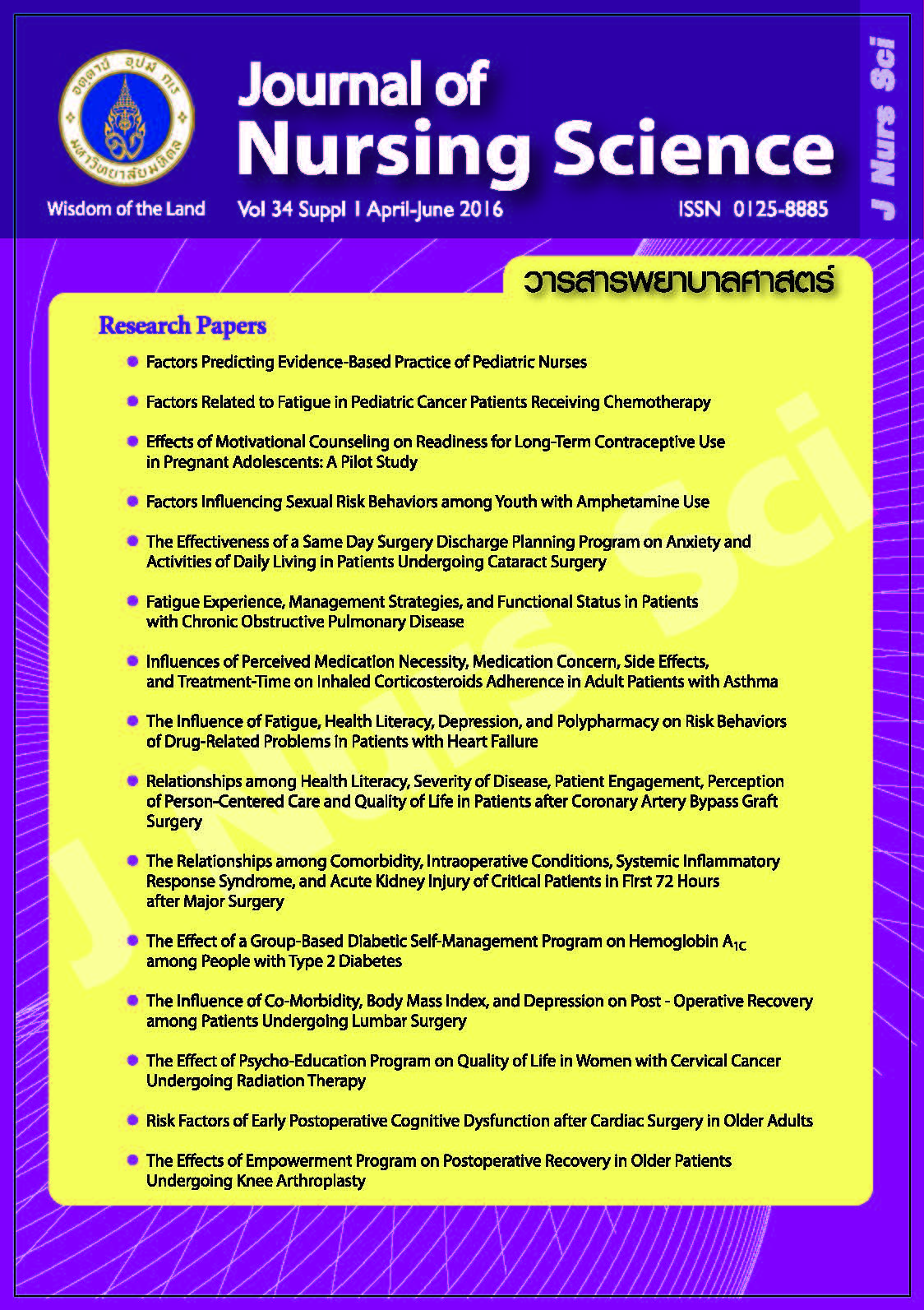The Effectiveness of a Same Day Surgery Discharge Planning Program on Anxiety and Activities of Daily Living in Patients Undergoing Cataract Surgery
Main Article Content
บทคัดย่อ
Abstract
Purpose: To investigate the effects of the same-day surgery discharge planning program on anxiety and activities in daily living of patients undergoing cataract surgery.
Design: Experimental design.
Methods: The samples consisted of patients aged 18 years old and older who underwent a same day surgery cataract surgery under the local anaesthesia at one tertiary hospital in Bangkok. The samples were randomly assigned into an experimental group and the control group. Research instruments included the same-day surgery discharge planning program, discharge assessment form, and a manual of patient education for patients undergoing same day cataract surgery. Data were collected by using a demographic characteristics questionnaire, an anxiety questionnaire, and the ability of activities of daily living questionnaire. Data were analyzed by using the Independent t- test
Main findings: The subjects in the experimental group had a mean score of anxiety during preoperative and pre-discharge (M = .56, SD = .71; and M = .04, SD = .02) lower than those in the control group (M = 1.11, SD = 1.01 and M = .33, SD = .62) with a statistical significant difference (t = -2.25, df = 50, p < .05 and t = -2.33, df = 50, p < .05). The experimental group also had a mean score of an ability to carry out activities of daily living (M = 76.36, SD = 4.72) higher than those in the control group (M = 70.92, SD = 7.36) with a statistical significant difference (t = 3.19, df = 50, p < .05).
Conclusion and recommendations: Nurses should apply the same-day surgery discharge planning program to provide nursing care for patients undergoing same day cataract surgery to decrease their anxiety level and increase the ability to carry out activities in daily life.
ประสิทธิผลของโปรแกรมการวางแผนจำหน่ายแบบผู้ป่วยนอกต่อความวิตกกังวลและความสามารถในการปฏิบัติกิจวัตรประจำวันในผู้ป่วยที่เข้ารับการผ่าตัดต้อกระจก
บทคัดย่อ
วัตถุประสงค์: เพื่อศึกษาประสิทธิผลของการใช้โปรแกรมการวางแผนจำหนา่ ยแบบผู้ป่วยนอกต่อความวิตกกังวลและความสามารถในการปฏิบัติกิจวัตรประจำวันในผู้ป่วยที่เข้ารับการผ่าตัดต้อกระจก
รูปแบบการวิจัย: การวิจัยเชิงทดลอง
วิธีดำเนินการวิจัย: กลุ่มตัวอย่างเป็นผู้ป่วยอายุตั้งแต่ 18 ปีขึ้นไป ที่เข้ารับการผ่าตัดต้อกระจก โดยเป็นการผ่าตัดแบบผู้ป่วยนอกด้วยวิธีระงับความรู้สึกเฉพาะที่ ในโรงพยาบาลระดับตติยภูมิแห่งหนึ่ง ในกรุงเทพมหานคร คัดเลือกกลุ่มตัวอย่างโดยการสุ่มแบบง่ายตามเกณฑ์ที่กำหนดเป็นกลุ่มควบคุม และกลุ่มทดลอง กลุ่มควบคุมได้รับการดูแลการพยาบาลตามปกติ กลุ่มทดลองได้รับโปรแกรมการวางแผนจำหน่ายแบบผู้ป่วยนอกที่มีการดูแลอย่างเป็นระบบต่อเนื่อง เครื่องมือ
ที่ใช้ในการวิจัย ได้แก่ โปรแกรมการวางแผนจำหน่ายแบบผู้ป่วยนอก แบบประเมิน การวางแผนจำหน่ายคู่มือการให้ข้อมูลผู้ป่วยที่เข้ารับการผ่าตัดต้อกระจก เก็บรวบรวมข้อมูล โดยใช้แบบสอบถามข้อมูลส่วนบุคคล แบบสอบถามความวิตกกังวล และความสามารถในการปฏิบัติกิจวัตรประจำวัน วิเคราะห์ข้อมูลโดยใช้ สถิติทดสอบ Independent t-test
ผลการวิจัย : กลุ่มที่ได้รับโปรแกรมการวางแผนจำหน่ายแบบผู้ป่วยนอก ค่าเฉลี่ยคะแนนความวิตกกังวลในระยะก่อนเข้าห้องผ่าตัดและก่อนจำหน่ายกลับบ้าน (M = .56, SD = .71; และ M = 1.11, SD = 1.01) น้อยกว่ากับกลุ่มที่ได้รับการดูแลตามปกติ (M = .04, SD = .02; และ M = .33, SD = .62) อย่างมีนัยสำคัญทางสถิติ (t = -2.25, df = 50,
p < .05 และ t = -2.33, df = 50, p < .05) และกลุ่มที่ได้รับโปรแกรมการวางแผนจำหน่ายแบบผู้ป่วยนอก มีค่าเฉลี่ยคะแนนความสามารถในการปฏิบัติกิจวัตรประจำวัน (M = 76.36, SD = 4.72) มากกว่ากลุ่มที่ได้รับการดูแลตามปกติ (M = 70.92, SD = 7.36) อย่างมีนัยสำคัญทางสถิติ (t = 3.19, df = 50, p < .05)
สรุปและข้อเสนอแนะ: พยาบาลและทีมสุขภาพควรสนับสนุนการนำโปรแกรมการวางแผนจำหน่ายแบบผู้ป่วยนอกไปใช้ในการดูแลผู้ป่วยที่เข้ารับการผ่าตัดต้อกระจก เพื่อช่วยลดความวิตกกังวลและเพิ่มความสามารถในการปฏิบัติกิจวัตรประจำวัน
คำสำคัญ: การวางแผนจำหน่ายแบบผู้ป่วยนอก ความวิตกกังวล ความสามารถในการปฏิบัติกิจวัตรประจำวัน การผ่าตัด ต้อกระจก
Article Details
ลิขสิทธิ์: วารสารพยาบาลศาสตร์เป็นเจ้าของลิขสิทธิ์ในการเผยแพร่ผลงานที่ตีพิมพ์ ห้ามผู้ใดนำบทความที่ได้รับการตีพิมพ์ในวารสารพยาบาลศาสตร์ไปเผยแพร่ในลักษณะต่างๆ ดังต่อไปนี้ การส่งบทความไปตีพิมพ์เผยแพร่ที่อื่น การนำบทความเผยแพร่ออนไลน์ การถ่ายเอกสารบทความเพื่อกิจกรรมที่ไม่ใช่การเรียนการสอน ยกเว้นเสียแต่ได้รับอนุญาตจากวารสารพยาบาลศาสตร์

Disclaimer: เนื้อหาบทความหรือข้อคิดเห็นใดๆ ในวารสารพยาบาลศาสตร์ ถือเป็นความรับผิดชอบของผู้เขียน กองบรรณาธิการไม่จำเป็นต้องเห็นด้วยและไม่มีส่วนรับผิดชอบแต่อย่างใด


